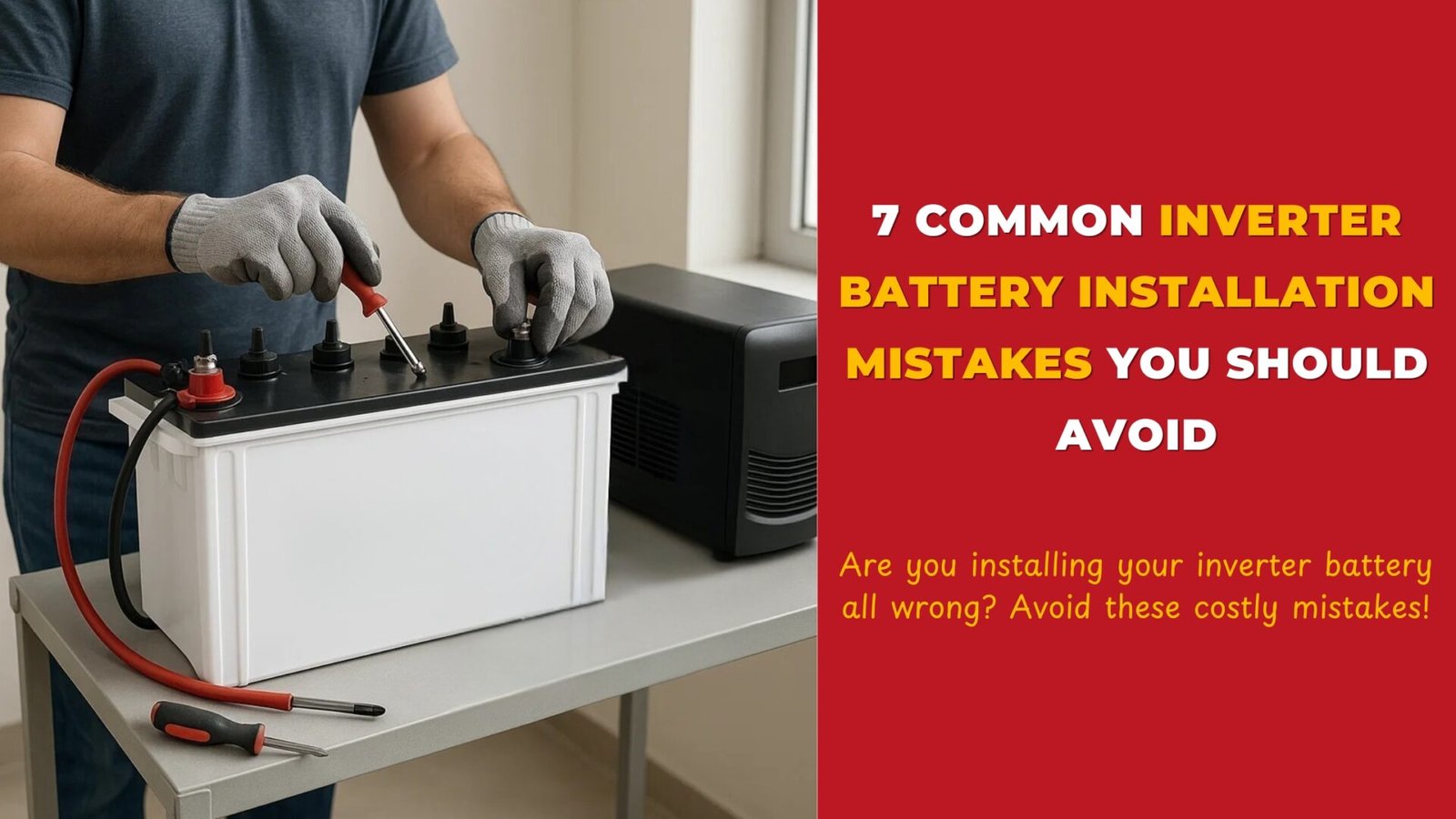In today’s world, uninterrupted power supply is more than a convenience — it’s a necessity. Whether at home, in an office, or in a commercial setup, power cuts can disrupt work, comfort, and productivity. That’s where inverter batteries step in, ensuring a smooth backup system.
But here’s the catch: even the best inverter battery can underperform or fail prematurely if it isn’t installed correctly. Inverter battery installation may look simple, but small errors can lead to big problems — reduced battery life, safety risks, and unnecessary expenses.
This blog highlights the most common inverter battery installation mistakes people make and offers practical tips to avoid them. Whether you’re supervising a technician or simply want to understand your system better, this guide will help you ensure your backup power runs safely and efficiently.
Why Installation Mistakes Matter
Many people assume that once they purchase an inverter battery, their job is done. However, poor installation practices can:
- Shorten the lifespan of your battery
- Lead to frequent breakdowns and inefficiency
- Cause overheating or even electrical hazards
- Void warranty if manufacturer guidelines are ignored
Even if you hire an electrician, knowing these key points ensures that you can monitor the installation process and protect your investment.
7 Common Inverter Battery Installation Mistakes
1. Wrong Battery Placement
What it is: Placing the battery in damp, hot, or poorly ventilated corners like under staircases or inside closed cabinets.
Consequences:
- Heat buildup reduces battery efficiency
- Moisture increases the risk of rust and electrical short circuits
- Shortened battery lifespan
How to Avoid:
- Always place the battery on a sturdy stand in a dry, cool, and well-ventilated space
- Keep it away from direct sunlight, heat sources, or water seepage points
2. Improper Terminal Connections
What it is: Loose connections, reversed polarity, or poor-quality clamps at the battery terminals.
Consequences:
- Sparks and overheating
- Risk of fire or inverter malfunction
- Frequent need for service calls
How to Avoid:
- Use high-quality, corrosion-resistant connectors
- Ensure terminals are tight but not over-screwed
- Double-check polarity (positive to positive, negative to negative)
3. Using Mismatched Battery and Inverter
What it is: Pairing a high-capacity inverter with a low-capacity battery or mixing old and new batteries.
Consequences:
- Poor performance and shorter backup time
- Extra load on the inverter leading to overheating
- Warranty issues due to incompatibility
How to Avoid:
- Match the inverter rating (VA) with the battery capacity (Ah) as per manufacturer guidelines
- Replace batteries in pairs for balanced performance
- Consult a professional before upgrading or mixing models
4. Ignoring Battery Ventilation
What it is: Keeping the inverter battery in a closed, air-tight room without proper airflow.
Consequences:
- Hydrogen gas buildup during charging → risk of explosion
- Reduced efficiency due to high operating temperature
- Unpleasant odors indoors
How to Avoid:
- Ensure the room has cross ventilation or install an exhaust fan
- Never place batteries inside sealed cabinets
- Leave enough space around the battery for air circulation
5. Overfilling or Neglecting Distilled Water Levels (For Flooded Batteries)
What it is: Adding too much or too little distilled water, or forgetting to refill on time.
Consequences:
- Overfilling causes leakage and terminal corrosion
- Low water levels damage battery plates permanently
- Reduced backup capacity and lifespan
How to Avoid:
- Check water levels every 2–3 months (frequency may vary by usage)
- Use only pure distilled water — never tap or mineral water
- Fill up to the recommended level indicator, not beyond
6. Skipping Load Calculation Before Installation
What it is: Installing an inverter without calculating the actual load requirement of appliances.
Consequences:
- Inverter overload, frequent tripping, and poor performance
- Wasted money on an oversized or undersized system
- Reduced backup time due to mismatch
How to Avoid:
- Calculate the total wattage of essential appliances (fans, lights, fridge, computer, etc.)
- Choose an inverter and battery system that matches your load and backup duration needs
- Always allow some extra capacity for future appliances
7. Ignoring Safety Gear and Fuse Protection
What it is: Installing the system without basic safety measures like fuses, circuit breakers, or insulated gloves.
Consequences:
- Electric shocks or short circuits during maintenance
- Severe risk of fire in case of overload or shorting
- Reduced protection for inverter and appliances
How to Avoid:
- Always install fuses or circuit breakers on both input and output sides
- Use proper safety gear while handling batteries
- Ensure the wiring is of the correct gauge and well insulated
Additional Tips for Safe Installation
To ensure smooth performance and long battery life:
- Always hire a trained professional or certified electrician
- Check product warranty and follow brand-recommended installation standards
- Schedule routine maintenance checks every 6–12 months
- Keep children and pets away from the battery area
- Monitor charging cycles to prevent overcharging or deep discharging
Conclusion
A reliable inverter battery system is only as good as its installation. By avoiding these seven common inverter battery installation mistakes — from poor placement and loose terminals to skipping load calculations — you can extend your battery’s life, improve safety, and enjoy uninterrupted power. Whether at home, in your office, or for a commercial setup, correct installation ensures maximum efficiency and peace of mind.
Final Tip: Don’t take shortcuts. Always prefer professional installation and routine checks to keep your inverter battery running smoothly for years.
Prevent common inverter battery issues before they occur! Ensure your system runs smoothly by choosing the right battery and professional installation from Vaibhav Enterprises. With expert guidance and high-quality products, you can enjoy safe, long-lasting performance, minimize maintenance issues, and have uninterrupted power whenever you need it.

